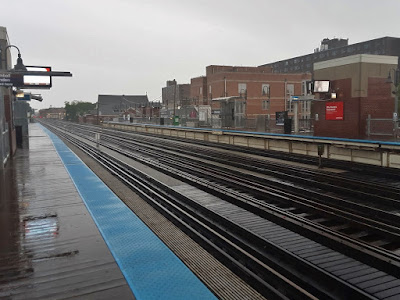On a Rainy Monday
Sprinting through the urban streets that were becoming increasingly less saturated with pedestrians, our small party finally halted at the drenched steps of an old building located in an obscure part of the city. It was Memorial Day afternoon in Chicago, but the deluge of rain had moved a majority of the crowds indoors. I and ten other museum professionals, on the other hand, had been willingly lured into the the storm as we made our way to the Ravenswood collection facility.
 |
| The Chicago "L" system (short for "elevated") platform was largely empty during a period of severe weather on Memorial Day. |
I was attending a workshop as part of a week-long collections conference, and had been delighted to receive an email the evening prior regarding an optional tour of the collections facility for the Peggy Notebaert Nature Museum (Chicago Academy of Sciences). "As if I would miss that!" I thought to myself.
After traveling by public bus and train for over half an hour to arrive at the Ravenswood collection facility, the group dove into the Museum's collection storage area. The storage space was much larger, and more dispersed, than the single storage room which I've gotten used to back in Cable. In fact, between two floors and at least four rooms, the Museum holds roughly 300,000 specimens. Their mammal collection alone--numbering over 5,000 specimens--is larger than the Cable Natural History Museum's entire collection!
With so many objects in storage, the group whizzed through a general overview of the facility and then took some time to view a select few specimens that our two tour guides were partial to.
As thunder rumbled in the distance, the soggy group first made our way through a work space on the forth floor where various items were routinely labeled and cataloged by a volunteer base of over 30 people. Dawn Roberts, Director of Collections, promptly led us to a current project where staff and volunteers have been working together to digitize nature photos (which will reveal the changing landscape of natural spaces around Chicago over a course of over 100 years).
 |
| Dawn Roberts is the only senior collections staff at Peggy Notebaert Nature Museum, but she has an assistant and numerous volunteers who assist with her many duties. |
Being partial to paleontology, the study of fossilized plants and animals, Dawn also made sure to direct us to an area of storage where Mazon Creek specimens were held. These natural objects were already of significance to a number of us in the group, as the conference also included a trip to nearby Mazon Creek fossil beds just two days prior. In concert, we oohed and aahed at the fossilized remains of giant cephalopods and delicate ferns for nearly twenty minutes.
 |
| Fossilized ferns (above) and a giant cephalopod (below) are just two of hundreds of fossilized flora and fauna representing Chicago's prehistoric past. |
The only other collections staff working at the institution at this time was Anna Chinn, Assistant Collections Manager and self-described mollusks nerd. When it came time for her to direct us through the dimly-lit halls that afternoon, she naturally concluded her tour in the room where they were stored. But first, I was happy for a few detours to the ornithology and mammalogy units.
 |
| Anna Chinn discusses the Museum's study skins of extinct species-- passenger pigeons, Carolina parakeets, and critically endangered ivory-billed woodpeckers. |
During that brief afternoon, I found something magical that I'm not sure many beyond museum folks would quite understand. Escaping the busy streets filled with the horns of angry drivers and loud splats of raindrops against metal, I had entered the still, quiet landscape of knowledge that I imagine only a museum storage facility or perhaps a library could hold. I was surrounded by a physical bank of information--not mere relics of the natural world. I was overwhelmed by my experience that day and correspondingly, returned to my hotel room and quickly took a nap.

